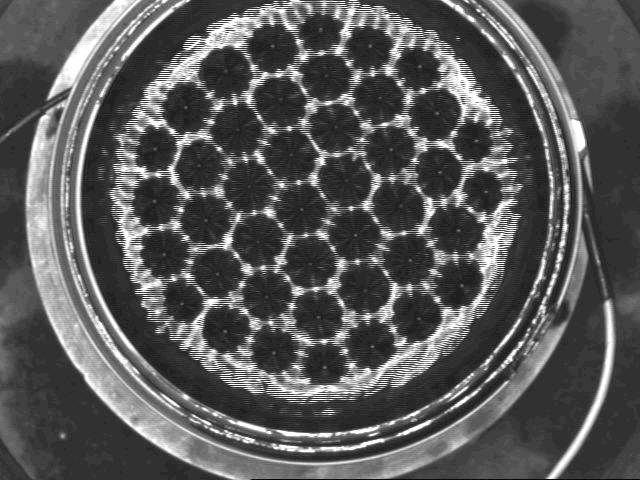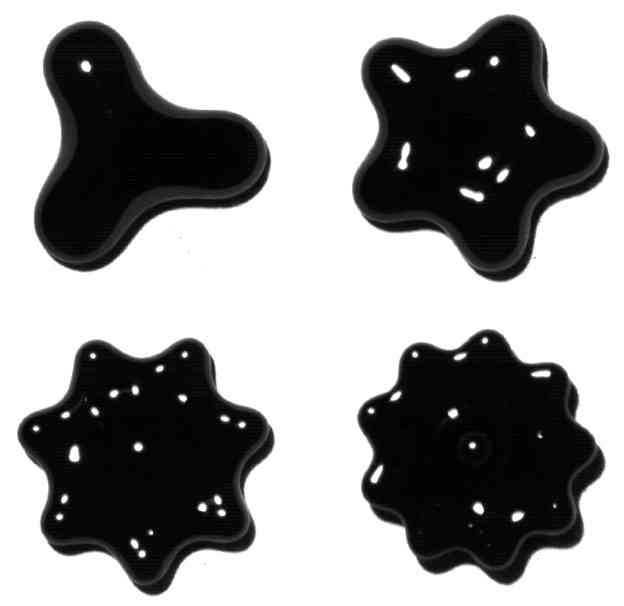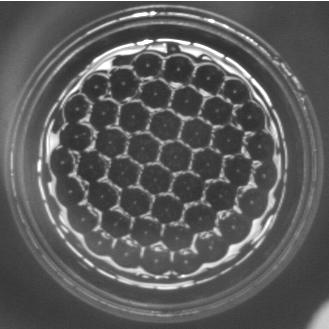 |
|
Ferrofluids (see papers by our group)
Tuning the resonant frequencies of a drop by a magnetic field
 Since Lord Rayleighs works in 1879, it is well-known that a drop of liquid displays oscillating lobes at its
surface when shaken. The dynamical study of the
resonant frequencies of such a drop occurs in
various domains including astrophysics (to model
stellar mass collisions), nuclear physics and
biology (to model nuclei), metrology (to measure
viscosity or surface tension) or industrial
applications (droplet manipulation in microfluidic,
optofluidic, and inkjet printer and pharmaceutical
industries). A new challenge would be to accurately
control and tune the natural oscillations of a drop
in a non-intrusive way to be able, for instance, to
shift its resonant frequencies to avoid some
annoying frequency bands in some fundamental or
applied situations.
Since Lord Rayleighs works in 1879, it is well-known that a drop of liquid displays oscillating lobes at its
surface when shaken. The dynamical study of the
resonant frequencies of such a drop occurs in
various domains including astrophysics (to model
stellar mass collisions), nuclear physics and
biology (to model nuclei), metrology (to measure
viscosity or surface tension) or industrial
applications (droplet manipulation in microfluidic,
optofluidic, and inkjet printer and pharmaceutical
industries). A new challenge would be to accurately
control and tune the natural oscillations of a drop
in a non-intrusive way to be able, for instance, to
shift its resonant frequencies to avoid some
annoying frequency bands in some fundamental or
applied situations.
Here, by adding ferromagnetic particles to a water
drop and varying the strength of an applied magnetic
field, we show for the first time that we are
experimentally able to efficiently tune the resonant
frequencies of such a drop. By energy conservation
arguments, we show theoretically that the magnetic
field contribution is equivalent to add an effective
negative surface tension to the drop. Beyond the
good agreement between the model and the experiments
with no fitting parameter, our study could have some
interest for potential applications. Indeed, the
weakness of the magnetic field strength, the small
size of ferromagnetic particles used are favorable
to miniaturization to plan to control the
oscillations of centimeter-to-micro-scale drop in a
new non-intrusive way. MORE and papers
Magnetically tuned folded structures
 A drop of liquid deposited on a
millimetric elastic membrane is wrapped by the
membrane if the latter is flexible enough, a
phenomenon called capillary origami. We renewed the
interest for this phenomenon, by using a drop of
ferrofluid - a liquid whose shape may be controlled
by a magnetic field. The magnetic field thus becomes
a control parameter to remotely drive the shape of
the origami.
A drop of liquid deposited on a
millimetric elastic membrane is wrapped by the
membrane if the latter is flexible enough, a
phenomenon called capillary origami. We renewed the
interest for this phenomenon, by using a drop of
ferrofluid - a liquid whose shape may be controlled
by a magnetic field. The magnetic field thus becomes
a control parameter to remotely drive the shape of
the origami.
We use a triangular membrane, leading to a
pyramidal-shaped origami. When the applied magnetic
field is increased, the origami undergoes an
overturn leading to a new configuration. This
dynamic instability is explained by an interplay
between the magnetic forces (which tend to stretch
the ferrofluid along the magnetic field) and the
gravitational forces (which tend to flatten the
liquid). The overturn instability, controlled in a
non intrusive way, is suitable for miniaturization
as lower magnetic fields are required for smaller
size membranes. It could therefore have interesting
applications for the manufacturing process of
micro-scale 3D structures, such as MEMs or
photovoltaic cells, based on elastocapillary
self-assembly. MORE and papers
Magnetic turbulent waves
Wave turbulence describes the
statistical behavior of a set of randomly
interacting waves and therefore has been applied to
a great variety of systems (ocean surface waves,
plasma waves in solar wind, spin waves in solids).
We report the first observation of magnetic wave
turbulence on the surface of a ferrofluid submitted
to a magnetic field, a regime that has not yet been
envisaged in theoretical studies.
When wave amplitudes are high
enough, the wave turbulence theory predicts a
nonlinear resonant process between waves which
generates smaller wavelengths. In a ferrofluid (a
liquid with a suspension of nanometric magnetic
particles), the dispersion relation of surface waves
was known to be tuned by applying a magnetic field.
This leads the authors to the first observation of a
magnetic wave turbulence regime. The existence
domains of gravity and capillary wave turbulence are
also documented as well as a triple point of
coexistence of these three regimes: these new
results are understood using dimensional analysis.
Such an experimental system where the dispersion
relation is tuned by the operator from a non
dispersive to a dispersive system is thus of primary
interest to test the wave turbulence theory. MORE and papers
Two-dimensional melting
The transition from a solid to a liquid phase in 2D
systems occurs in numerous domains including solid-state
physics, thin colloidal suspensions, liquid films,
vibrated granular monolayers, and vortex lattices in
superconductors. However, melting of 2D solids is a much
less understood phenomenon that for 3D solids. We have
designed an unusual system to investigate the 2D melting
of a macroscopic analogous of a crystalline lattice: we
have observed the transition from an ordered solidlike
phase to a disordered liquidlike phase of a lattice of
spikes on a ferrofluid surface submitted to horizontal
sinusoidal vibrations. The onset of the melting transition
and the structural changes across the transition (solid,
hexatic and liquid phases) are found in good agreement
with the theoretical predictions of 2D melting (KTHNY
theory) whose universality is controversial. Our
dissipative out-of-equilibrium system exhibits strong
similarities with 2D melting of equilibrium systems in
solid-state physics. These results could thus contribute
to develop a comprehensive statistical mechanics of
non-equilibrium phase transitions. MORE and papers
Axisymmetric solitons
Solitary waves or solitons are
localized nonlinear waves that propagate almost without
deformation due to the balance between the nonlinearity and
the dispersion. Solitons are ubiquitous in hydrodynamics,
optics and condensed matter. However, most of them
propagates within a quasi-one-dimensional plane system.
Observation of axisymmetric solitary waves is much more
scarce. We have designed an experiment to observe
axisymmetric solitary waves on the surface of a cylindrical
magnetic fluid layer. Generally, in a usual fluid, a
cylindrical fluid layer is unstable and droplets appear
(Rayleigh-Plateau instability). By using a ferrofluid (a
colloidal suspension of magnetic nanoparticles), it is
possible to stabilize this cylindrical fluid layer. To wit,
a metallic tube carrying an electrical current creates a
magnetic field which stabilizes the cylindrical layer of
ferrofluid around the tube due to the magnetic centripetal
force. Both the shape and the speed of the solitary waves
are modified by the strength of the magnetic field. Such a
system allows us to observe for the first time the
axisymmetric magnetic solitary waves predicted theoretically
in the 80s. The study of collisions between these new type
of solitary waves should be of particular interest.
MORE and papers
Interplay bewteen Rosensweig and Faraday instabilities:

We report an experimental study of the inhibition of the
instability generated by a magnetic field applied
perpendicularly to the surface of a magnetic fluid
(the Rosensweig instability), by vertical vibrations
of the fluid container. Our measurements are in
quantitative agreement with a simple analytical model
using the theory of Mathieu functions. Paper

Physical Review E 108, 045106 (2023)
Experimental evidence of random shock-wave intermittency
11. G. Ricard and E. Falcon 2023
Physical Review Fluids 8, 014804 (2023)
Transition from wave turbulence to acousticlike shock-wave regime
10. E. Kochurin, G. Ricard, N. Zubarev, and E. Falcon 2022
Physical Review E 105, L063101 (2022)
Three-dimensional direct numerical simulation of free-surface magnetohydrodynamic wave turbulence
9. E. Kochurin, G. Ricard, N. Zubarev, and E. Falcon 2022
Physical Review E 105, L063101 (2022)
Three-dimensional direct numerical simulation of free-surface magnetohydrodynamic wave turbulence
8. G. Ricard and E. Falcon 2021
EPL (Europhysics Letters) 135, 64001 (2021)
Experimental quasi-1D capillary-wave turbulence on the surface of a fluid
7. T. Jamin, Y. Djama, J.-C. Bacri, and E. Falcon 2016
Physical Review Fluids 1, 021901(R) (2016) - Rapid Communication
Tuning the resonant frequencies of a drop by a magnetic field
6. T. Jamin, C. Py, and E. Falcon 2011
Physical Review Letters 107, 204503 (2011)
Instability of the origami of a ferrofluid drop in a magnetic field
5. S. Dorbolo and E. Falcon 2011
Physical Review E 83, 046303 (2011)
Wave turbulence on the surface of a ferrofluid in a horizontal magnetic field
4. E. Bourdin, J.-C. Bacri, and E.Falcon 2010
Physical Review Letters 104, 094502 (2010)
Observation of axisymmetric solitary waves on the surface of a ferrofluid
3. F. Boyer & E. Falcon 2009
Physical Review Letters 103, 144501 (2009)
Two-Dimensional Melting of a Crystal of Ferrofluid Spikes
2. F. Boyer & E. Falcon 2008
Physical Review Letters 101, 244502 (2008)
Wave turbulence on the surface of a ferrofluid in a magnetic field
1. F. Pétrélis, E. Falcon, and S. Fauve 2000
European Physical Journal B, 15, 3 - 6 (2000)
Parametric stabilization of the Rosensweig instability